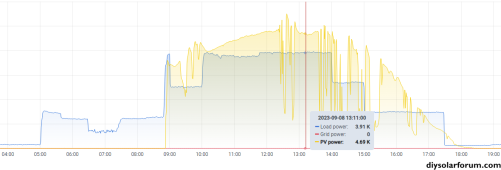This has happened to me a few times, generally after a bad solar day (yesterday was quite rainy in south western Ontario, in the morning, the solar does not engage, even after the sun is fully up.
I got a SFF 8000T DVM-MVP, with a max solar voltage of 250v, 3s7p 300w Silfab panels, charging my 35kw custom made lithium-ion pack, so I dont think it is the solar voltage spiking.
Do see in my solar assistant a voltage spike at 2300 of 200v, still not reaching the 250v my inverter can use.
My solution so far as been to disconnect the solar via DC breakers, and wait until the capacitors on the solar side discharge to under 40v, then turn it on, fixes it every time, no need to shut down the inverter.
has any conclusion has been drawn into what may cause this?
I got a SFF 8000T DVM-MVP, with a max solar voltage of 250v, 3s7p 300w Silfab panels, charging my 35kw custom made lithium-ion pack, so I dont think it is the solar voltage spiking.
Do see in my solar assistant a voltage spike at 2300 of 200v, still not reaching the 250v my inverter can use.
My solution so far as been to disconnect the solar via DC breakers, and wait until the capacitors on the solar side discharge to under 40v, then turn it on, fixes it every time, no need to shut down the inverter.
has any conclusion has been drawn into what may cause this?



